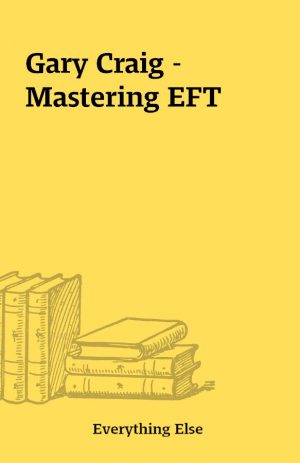Entheos Academy – How to Befriend Your Brain to be a Genius at Anything with Srini Pillay
How to Befriend Your Brain to be a Genius at Anything.mp4
[WebRip – 1 MP4]
Description
Class OverviewWhether you are switching to a new job, finding a new relationship, wanting to improve your sex life or simply to lose weight, knowing how to befriend your brain is critical to your success. (Check out the Top 10 Big Ideas from the class below!) Your ProfessorSrini Pillay, M.D. is an Assistant Clinical Professor at Harvard Medical School. He is the former Director of the Outpatient Anxiety Disorders Program and the Panic Disorders Research Lab at McLean Hospital.How to Befriend Your Brain to be a Genius at AnythingRegardless of what you are trying to do, your brain has to be involved. Whether you are switching to a new job, finding a new relationship, wanting to improve your sex life or simply to lose weight, knowing how to befriend your brain is critical to your success. Why? Your brain is where all important decisions are processed. It is also where you store your memories, form your intentions, and also what needs to activate before you act. You can’t do anything without involving your brain: Eating, walking, kissing, reading or breathing. To be a genius at anything, you should know how to work with your brain, or even better, befriend it. In this course, you will learn TEN big ideas that are completely counterintuitive or surprising, to more effectively use your brain. We will also go into the research and instant applications, so that your brain can guide you to the genius that you are. The Top 10 Big Ideas1 Avoid “No” At GoWhen you are about to start something, you usually tell yourself what you need to do and what to avoid. If for example, you are carrying two glasses of red wine past a couch, you self instruct your brain: “Do not drop the red wine.” Well, guess what? A world-renowned researcher, Daniel Wegner, studies this phenomenon and found that under stress, the brain does not hear the word “no” and will do the exact opposite of what you want. So, one quick way to befriend your brain is to give it instructions that it is wired to obey. To do this, avoid the “no” when deciding what to do. It will save you a lot of hassles.2 Hear Your FearWhat is the commonest thing you do when you hit a wall in your thinking? You tend to think more, right? Ask other people for ideas. You wrack your brains until you can come up with something, and often you can’t find an answer. Well, guess what? Your brain’s thinking center is directly connected to its fear center. Fear can cause earthquakes in your brain without your ever knowing it. And when it does, these earthquakes cause aftershocks in your brain’s thinking center. So, you hit a wall in your thinking, and it’s not because you can’t think. It’s because your fear is causing your thoughts to crash. In this case, thinking any harder is not going to help. You need to actually dial down the feeling. 3 Advance to ChanceRecent brain imaging studies tell us that when we are uncertain, the brain can act in two ways. These “light bulbs” have to be turned on in the brain or else you will just freeze. So you literally have to tell your brain to do these things. It will love you for it. The first way is called “serial hypothesis testing.” This simply means: test out where you think you should go (e.g. Try out online dating services before you completely squash the idea). But an even greater capacity is called “predictive inference.” This simply means-you have no idea what the right thing is, and no amount of thinking is going to get you to your goal. In this case, you act, and then think. In the world today, this is one of the most counterintuitive but important things. Here, rather than analyze your date to talk yourself out of meeting them, you check out your safety, and only make decisions once you meet them. This will open up a whole new world for you.4 Map the GapNothing in life actually makes that much sense. And your brain can’t stand that. So when there are gaps in your logic or your story, your brain will make up whatever it has to so that the story sounds complete. “Let’s get real”, your brain will say. “There is no way you are going to be a billionaire. What are the realistic chances of that?” And then, your brain will seek out all the facts to justify this hypothesis and you will live your life out according to this plan. Watch out for brain gaps. The brain is seriously wired to make up stories. We call this the continuity illusion. When there are gaps in your thinking, be curious until the meaning comes to you rather than being impatient to make up the rest of the story. 5 Pitch the SwitchWhatever it is you want in life is going to require a change. But your brain is wired to see what you need, and then ignore it. You see-to truly change, you have to pay a price. This price is called switch cost. And your brain has to be on board, or else it will tell you that the price it too high and leave. How do you convince your brain that the price is right? You have to really focus on why it is worth giving up your familiarity, comfort, certainty and mastery. And you need to frame it this way. Once you do, your brain will search on its own for this justification. This applies to anything-weight loss, money, relationships-all major life decisions to change have a switch cost. Knowing how to manage this is critical.6 Click DepictSo do you know where you are going in your life? And more importantly, is your brain on board with your goal? Being “on board” means being “committed”, and to increase your brain’s commitment, you simply have to activate the left frontal cortex. How do you do that? You imagine. Yes, imagine. Elite athletes have used this technique for years, but there are some subtleties that you need to know. One example is: imagine in the third person before you imagine in first person. That is, you see yourself driving in your flashy new car before you see the road in front of you. Your brain sometimes freaks out with first person imagery, so you want to ease into it. Make sure it is ready for the real thing. 7 Ignore the ShoreWhenever you have a goal, you tend to want to pay attention to it, like a ship at sea waiting to reach the shore. But looking at the shore will not get you there faster or more easily. The brain responds more effectively if you internalize the goal and memorize where it is relative to where you are. Simply put-be in the moment after you have memorized where your goal is rather than looking at the end all the time.8 Slice the PriceWhen the brain has a goal, the time to reach it may be too long. The amount you have to pay in switch cost may also be too much. So do it in increments. This may sounds obvious, but it is less obvious when you are failing. The next time you try something and fail, ask yourself: How can I do this in smaller increments? When you do, the brain does two things: it has more times to feel rewarded because reaching every small goal feels like a reward; and it also is less overwhelmed by what it has to do and can hold them in the short-term memory cup more easily without it overflowing.9 Suspend the LensWhen something is not working out, it makes sense to stop doing what you are doing and then make good use of a time-out. The lens through which you view life is often more of a problem than life itself. If you suspend the lens and then change it, you may find that the solution appears to be more obvious. For example, I just came from a meeting where I was wondering how to partner with someone. We have been at this for awhile, and getting closer but not really sure how we should do this. Then, when he mentioned another person, I suddenly realized that our partnership needed a third person and this then created a whole new lens through which we could view our partnership.10 Prevail to FailThis sounds counterintuitive but the reality is successful people fail much more than unsuccessful people-they just know how to recover better. Recovery from failure is often difficult as it feels like a blow to the stomach, but learning how to fail effectively can be a sure path to success. Every time you try to get somewhere and hit a wall, it is a chance to change direction. Eventually, some path will open up and be clearer. When you prevail and are determined, you should not only expect but even welcome failure. The brain, if taught to not freak out at failure, will learn to see it as an opportunity.These are ten ways to engage your brain to manifest your highest form of genius and to be a champion at whatever you do. In the lesson, we will look at each in more detail, but also plot a path for your success so that you can shorten the time to reach your most pressing goal.
You must be logged in to post a review.






Reviews
There are no reviews yet.